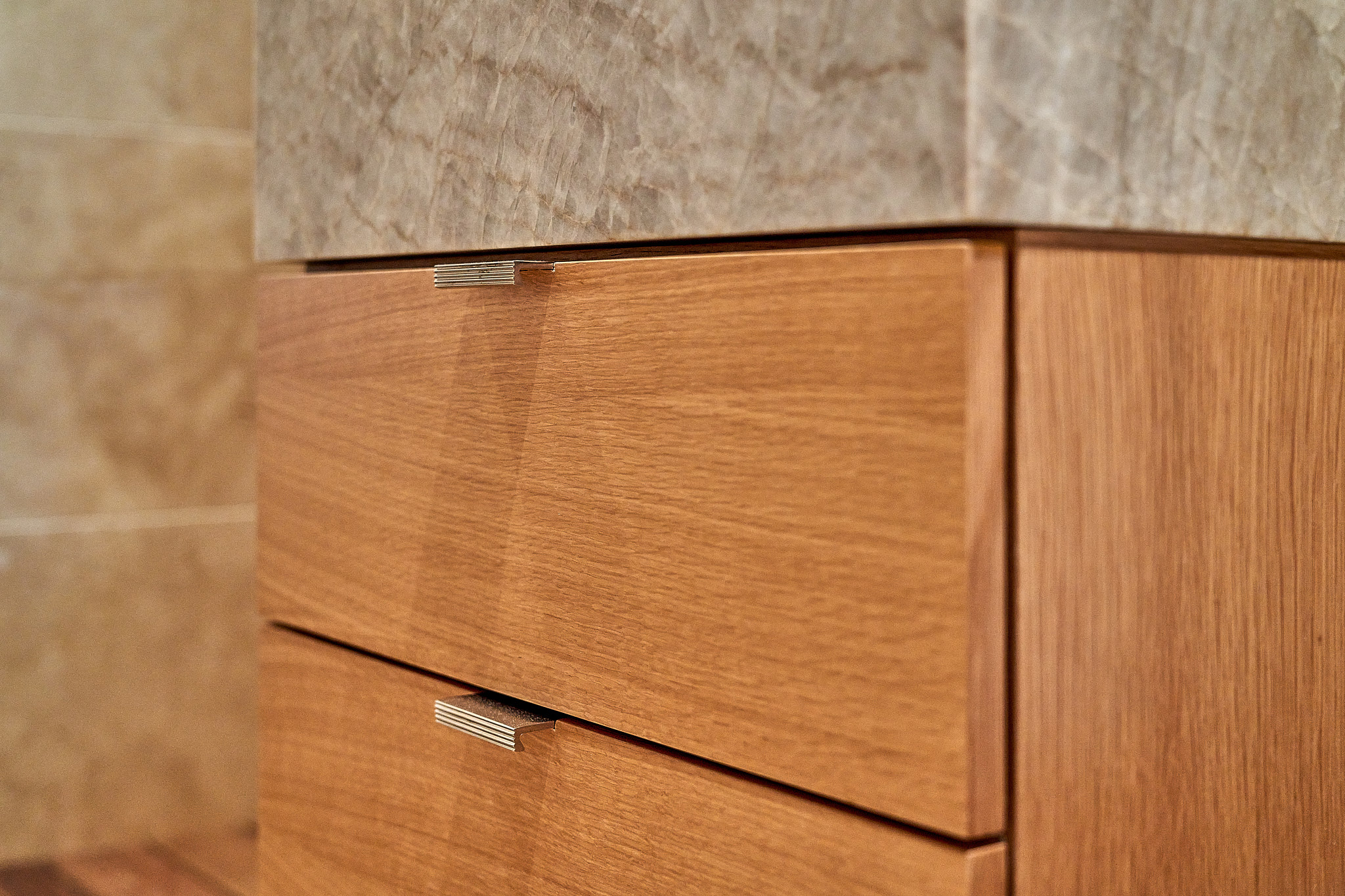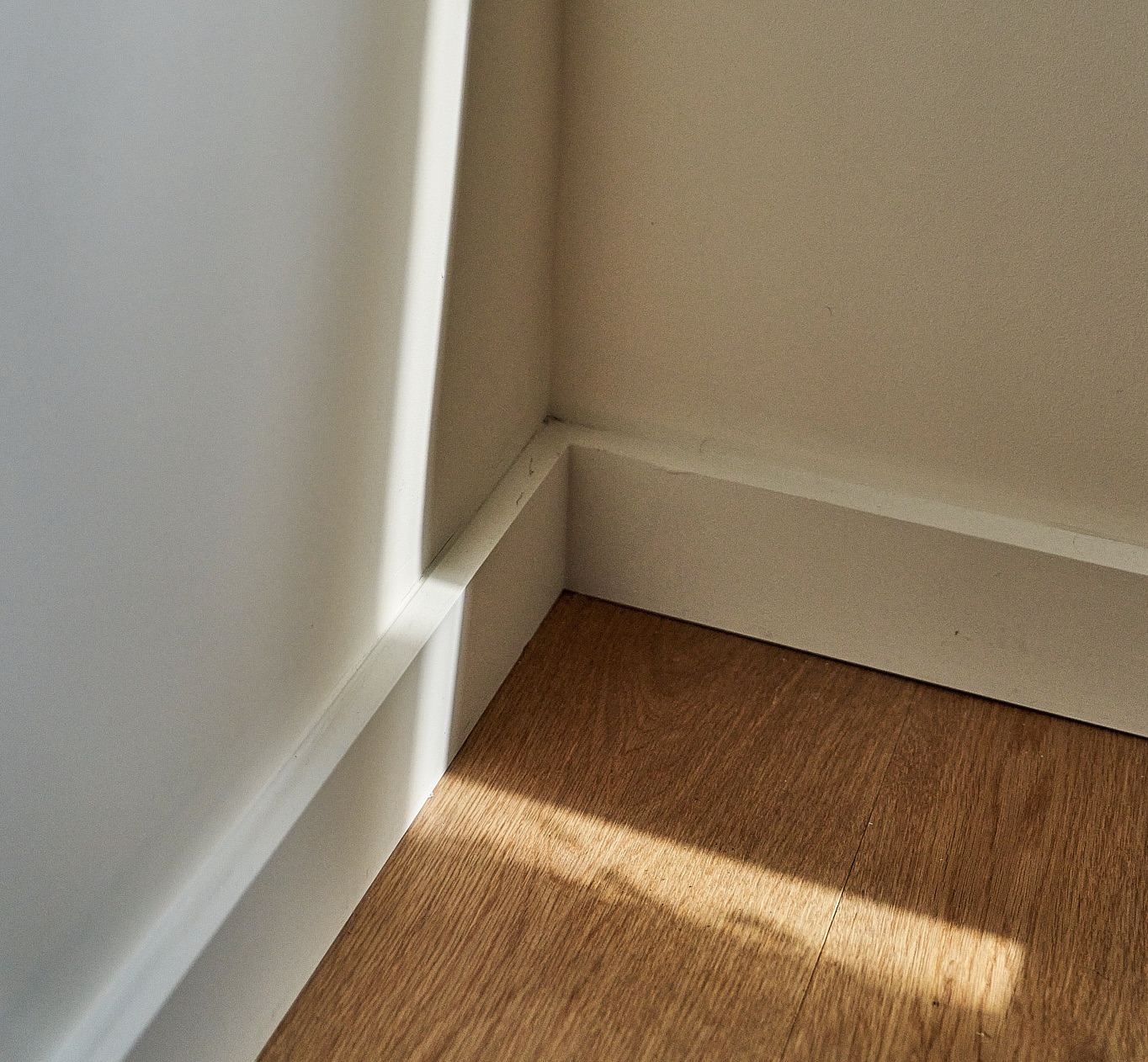What’s involved in renovating a post-war co-op or condo apartment in NYC?
- Post-war places tend to be smaller and have lower ceilings with concrete slabs
- 'We focus on paring down materiality and expressing functionality to bring these spaces to life'
- A custom vanity and sink is 'always' worth it when upgrading a small NYC bathroom

Textured materials, minimal hardware, and smart storage were key elements of this post-war kitchen renovation by Mammoth.
Pratya Jankong
Living in one of the city’s glazed white-brick buildings from the 1950s and '60s is the dream for many style-conscious New Yorkers who appreciate iconic midcentury architecture. When buying in these post-war co-ops or condos (as with those of any era), you might find that the individual units require a pre-move-in renovation.
That was the case for buyers Matt Caverly and Angela Hu. "We happen to like the clean exterior of the building we chose. When we closed, the apartment had potential but a long way to go—it clearly hadn't been touched in decades, and some prior design choices were idiosyncratic, to put it nicely," Caverly says. (The walls of one bathroom were entirely covered in mirrors!)
Given the preponderance of prewar buildings in NYC, finding a design pro who understands how to update post-war spaces for today's lifestyle while preserving their distinctive aesthetics is a critical first step.
“Post-war places do tend to be smaller and have lower ceilings but rather than fight that, we embrace these characteristics in making the space the best version of itself,” says Maryana Grinshpun, founder of Mammoth, a full-service design firm that specializes in urban renovations. “We focus on the whole post-war ethos of paring down materiality and expressing functionality to bring these spaces to life,” she says.
So when renovating Matt and Angela's 1,100-square-foot, two-bedroom, two-bath co-op in the East Village, “We went in an earthy direction by using natural materials to introduce texture while at the same keeping it monochromatic and very simple,” Grinshpun explains. She says their desire for a low-maintenance lifestyle also informed the choice of materials—for example, choosing soapstone instead of marble for the kitchen countertops, travertine in the bath, and quartzite for vanities—all natural stones that bring warmth into a home but tend to age gracefully.
This project is a good lesson in how to approach your own post-war renovation. Read on for the main focus points and solutions.

How to bring in more light
Post-war units tend to have low ceilings—eight feet is typical—as well as concrete slabs, which most buildings will not allow you to channel into for adding recessed lights or junction boxes, says Mammoth co-founder Jessica Maktal.
The ceilings don’t have many pre-wired points for installing lights, either, and existing ones are not often in ideal locations. “For example, the entire living room and dining room of the East Village project had only one point where we could have placed a dining room light fixture; it wasn’t in the ideal location for where we wanted to locate the dining table. The building would also not allow us to channel into the concrete to move it, as is often the case,” Grinshpun says. “So we ignored that point, hung two lights side by side from the ceiling, and wired those to the wall such that the exposed wiring became a beautiful design element.”
In addition to the heavy use of “swag lights” (lights where exposed wiring is thoughtful and part of the design intention), Mammoth often installs track lighting, which only requires one point. Sconces are another great option because you can add wiring in the walls (as installed in the East Village primary bed and bath, respectively).

How to make the kitchen more functional
Smaller spaces, in general, can feel messy very quickly, so providing enough storage in post-war apartments is usually a top priority—"even leaving a few items out can make a tight space appear cluttered. That’s why floor-to-ceiling units are important in providing places to put all your stuff," Grinshpun says.
Implementing custom storage is particularly helpful in the kitchens, which are for the most part narrow galley layouts that are separated from the dining area by a wall that can usually come down.
In the East Village project, that meant installing floor-to-ceiling cabinetry on the back wall, upper cabinetry over the sink, and a grid of drawers under the island. Paring down the hardware by using built-in pulls and integrating the appliances (refrigerator and dishwasher) further helps the space look uncluttered, as does continuing the same soapstone used for the countertops as the backsplash behind the sink and range. "There, we created this dramatic wall for added texture and dimension. Removing the upper cabinets on the long wall of the kitchen (while finding that storage in the pantries and island storage) helped open the space more. It just feels lighter, and more modern." Grinshpun says.

How to update small bathrooms
Here’s where Mammoth embraces the existing tight space in creating a sense of intimacy.
One way to achieve that is with materiality. “We covered the floor and walls with travertine—the monochromatic palette adds warmth and texture," Grinsphun says. "Ipe wood slats in the shower stall break up the monotony and produce a spa-like effect. They also help make the four-inch overflow curb, required (by management) in most NYC apartments, more seamless."
Mammoth also constructed new dropped ceilings to add recessed lighting "because we felt it was important to provide sufficient ambient lighting," Maktal says. "The overall footprint of the room is small, so the lower ceiling height remains proportionate to the rest of the space."
According to Grinshpun and Maktal, building custom vanities and sinks is always a great investment when working within tighter dimensions—"off-the-rack options often won't maximize storage, or blend so seamlessly with the look you’re trying to create."
Shown below is a quartzite sink set in an oak vanity. “We pared down the materials with edge pulls, which we found from a small manufacturer in England. They have an engraved pinstripe for added detail and interest."

The plumbing fixtures are a nod to the midcentury lineage of the apartment. “It’s like what they say about food—'what grows together goes together’ in that these are inspired by a classic Danish design by Arne Jacbosen for Vola from roughly around the same time as these buildings.
"They are iconic in the world of architecture, as they were the first to hide all of the mechanical workings of a faucet behind a wall, and only leave the spout and handle exposed," Grinsphun explains. "At the time, it was sort of mini-revolutionary. But more importantly, it works well within the outlines of this home, predicated on the same design principles.”

How to mine a fixed layout for maximum use
You may not be able to move the rooms around, but you can still rethink the way those rooms are used.
For example, you can repurpose secondary spaces, such as using a spare bedroom as a study-slash-guest room (as in the East Village co-op), a workout room, or a dedicated kids' playroom.
Or you can create a new room within a room. “Very often we are able to carve out these interesting spaces, such as the dressing area leading from the primary bedroom to the bathroom in the East Village,” Grinshpun comments. There she built custom closets on either side behind wood doors from IKEA. She then found wood-veneer wallcovering to match the doors, installing it on the walls and ceiling.

Are there other ways to make the space more modern?
Two elements often come into play: floors and doors.
Replacing the floors with wider planks can help the space look up-to-date. Grinsphun notes that a tenet of design is that the width of the plank should be proportionate with the ceiling height. In the East Village apartment, that worked out to be about a seven-inch plank.
Raising the door heights (almost to the ceiling) also adds a modern touch. Maktal notes that a sleek, flat-stock baseboard looks best in post-war spaces—and suggests "staying away from more ornate or traditional moldings that aren't in keeping with the age of the building construction."
What are practical considerations that could impact the cost?
Skim-coating, which involves plastering over existing walls and sanding that plaster down for a smooth finish, is often recommended in renovations. But it can be expensive, so it often comes down to budget. “With older prewar apartments, it’s plausible that someone semi-recently skim-coated the walls and they are in decent shape,” Maktal says. "With post-wars, the quality of the paint job is often poor, with either heavy roller texture or uneven texture—perhaps the work of supers or owners themselves spot-fixing over the years—that can seem at odds with other newly renovated surfaces."
Another factor common to buildings that went up in the 1960s and '70s is the use of asbestos as a binding agent, such as for vinyl flooring inside a closet, or as part of the foam insulation around plumbing.
“It’s not harmful when left in place, but if you are exposing the asbestos during construction, it would become airborne and must be abated,” Grinshpun explains. Therefore, you generally are required to conduct asbestos testing before submitting your plans for approval by the NYC Department of Buildings.
Again, this is something to discuss with your architect or designer and to factor into your overall bottom line. Expect to pay around $1,000 to $1,500 for testing. "We ran the new flooring on top of the existing parquet to avoid this issue," Maktal says.
Ultimately, the goal of renovating a post-war apartment is the same as any other type of NYC property—to have a home that suits your goals and lifestyle.
"The transformation is night and day," Matt and Angela say. "Maryana did a fantastic job creating a modern aesthetic that includes natural stone and wood textures throughout. We couldn't be more pleased with the outcome."
Mammoth is a woman-owned and -run design-build firm with a studio in Dumbo and extensive experience in the urban renovation market. We specialize in a thoughtful, efficient, streamlined design-build process with a design-first approach. Ready to renovate? Contact us for a complimentary consultation.


























